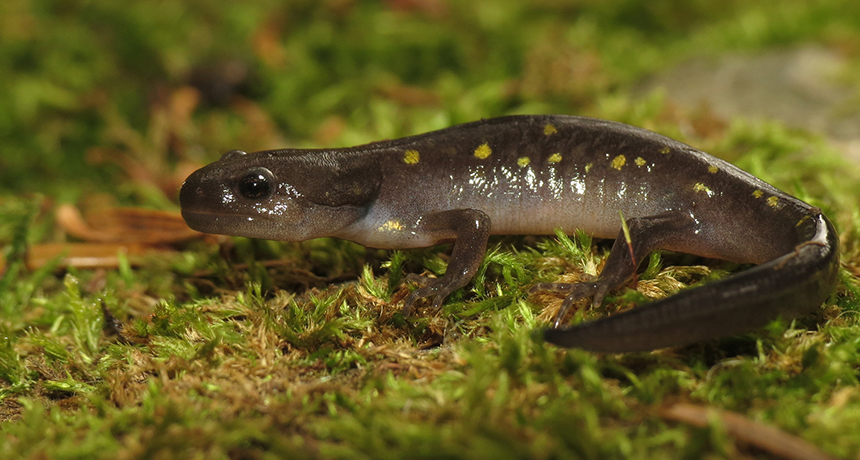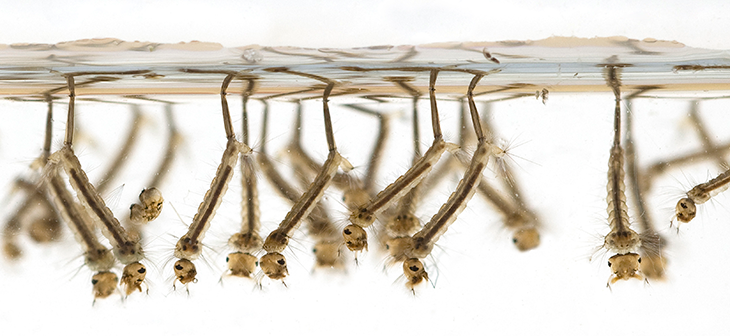Mosquito repellent could pose risks to baby salamanders
One repellent killed young salamanders in the lab — but not the mosquito larvae they eat

Young spotted salamanders eat plenty of mosquito larvae. Waterborne bug spray could deform or kill youthful salamanders — but not the mosquitoes.
Fyn Kynd/Flickr (CC BY 2.0)
Share this:
- Share via email (Opens in new window) Email
- Click to share on Facebook (Opens in new window) Facebook
- Click to share on X (Opens in new window) X
- Click to share on Pinterest (Opens in new window) Pinterest
- Click to share on Reddit (Opens in new window) Reddit
- Share to Google Classroom (Opens in new window) Google Classroom
- Click to print (Opens in new window) Print
The spray you use to keep bugs from biting can end up in local waterways. From there, the chemical can make its way to baby mosquitoes and the young salamanders that eat them. Insect repellant doesn’t do much to the larval mosquitoes. But it can harm salamanders, a new study shows.
People around the world use chemicals to protect themselves from insects and the diseases they can spread. The Centers for Disease Control and Prevention recommends using a bug spray with either of two chemicals. They are N,N-diethyl-meta-toluamide (or DEET) and picaridin. Each does a good job of keeping bugs away.
The chemicals don’t stay on skin, though. They wash off and can end up in local streams and rivers. That might happen directly when people swim outdoors. More often, the chemicals wash off in the sink or shower. Then they go down the drain and survive wastewater treatment.
“We see DEET everywhere that people show up,” says William Battaglin. “In national parks, remote locations in the atmosphere, it’s very persistent.” As a hydrologist, Battaglin studies water flow and the chemicals in water. He works for the U.S. Geological Survey in Blakewood, Colo., and was not involved in the study.
DEET and picaridin could affect animals living in polluted water. Mosquitoes, for instance, lay their eggs in water. Those eggs hatch and become worm-like larvae that dangle just below the water’s surface. Other creatures, including young salamanders, dine on those larvae.

Rafael Almeida is an ecologist, a scientist who studies how organisms and their environments interact. He works at Cornell University in Ithaca, N.Y. Almeida was curious about how water polluted with insect repellants might affect aquatic wildlife. Adult mosquitoes are easily driven off by insect repellant. But what about their babies? Would the spray repel or poison them? And what about other species — such as young salamanders — that dine on larval mosquitoes?
Spraying salamanders away
Almeida and his colleagues headed to a pond in New York. There, they scooped up the young spotted salamanders (Ambystoma maculatum) and larval mosquitoes.
In the lab, the scientists split the critters into groups. Each group had 9 salamanders and 30 mosquitoes. For 25 days, the researchers exposed the groups to four different amounts of bug spray with DEET or with picaridin. The amount of either repellant used was similar to what animals might experience in the wild.
None of the insect repellants affected the mosquito larvae. The bug spray with DEET didn’t harm young salamanders, either. But the repellent with picaridin was a different matter. The tails of salamanders exposed to that repellent began to twist and deform. This happened after only four days. After 25 days, the lowest dose of picaridin bug spray killed nearly half (45 percent) of the young salamanders. The highest dose killed 65 percent. A control group of salamanders was not exposed to either repellant. That group developed no tail deformities or deaths.
Nine salamanders per group is not very many. Studying more animals would give scientists a better idea of what’s happening. It’s possible that in a larger group of these amphibians, the scientists wouldn’t see these effects.
But if repellant chemicals are harming wild salamanders, it could be bad news. Populations of these amphibians have been declining around the world. Causes include pollution, a changing climate and humans taking over their habitats. Insect repellants could one source of that pollutant stress.
What’s more, fewer salamanders could ultimately mean more mosquitoes — and the diseases they carry. If baby salamanders aren’t around to eat baby mosquitoes, more skeeters might make it to adulthood. That means repellent water pollution might actually increase the number of these insects. Almeida and his colleagues published their work October 31 in the journal Biology Letters.
The researchers used the same bug sprays you can buy in stores today. “It’s interesting they used [them] instead of the ingredients,” Battaglin says. “It makes it hard to figure out what is causing the issue.” It could be the picaridin. Or it could be some other chemical in the spray.
Almeida agrees that other ingredients could be to blame. So the next step is to test those ingredients separately.
But this research is not an excuse to skip the spray when you’re outdoors in buggy areas, Almeida cautions. “Bug spray is important in avoiding mosquito-borne diseases,” he explains. “It’s too extreme to tell people to stop wearing bug spray.”
Instead, he says, researchers need to learn more about what DEET and picaridin might be doing in the environment. And they need to find ways to keep bug spray out of the water.







